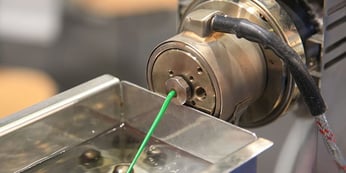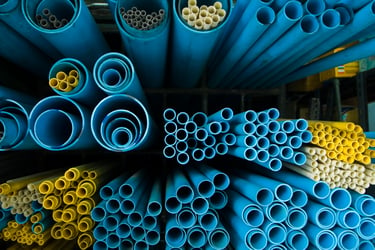
Extrusion applications vary greatly depending on the application. Wire coating, Compounding, Fiber, Sheet, Profile, Cast Film, and Blown Film are just a few examples of different extrusion processes. The extruder itself can vary as well when you consider screw design, size, twin vs single, etc. but the genesis remains the same. The motor turns the screw at a desired RPM, pulls pelletized resin from the hopper through the feed throat, melts the plastic resin as it passes through the different zones of the screw and a uniform plastic melt exits the end of the screw ready to travel through the downstream equipment.
Some processors just need to clean the screw and barrel and that is usually a fairly straight forward process. The specific grade of purging compound depends on several factors including the type of production resin being ran, processing temperatures of the production resin, colorants or other additives, issue that is being addressed, and several others.
When a purge is needed for elements that are beyond the screw and barrel that is when design and build of the die and a technical understanding of what is actually happening becomes really important. Beyond the end of the screw we sometimes see screen packs, melt pumps, static mixers, and feed blocks for co-extrusion applications. Beyond that you come to the die and depending which application is being discussed the varied types and styles of extrusion dies are numerous. The same factors that go into the grade recommendation for the screw and barrel still hold true for the die such as production resin, temps, colorants, etc. However, the grade of purging compound recommended to clean the die area includes some other factors to think about.
We always want to establish what type of issue is taking place within the system that the correct purge can eliminate. Are we looking at color or material changes, contamination that is building up in the die area, low flow or high pressures, complete cleanout after a run, or shut down and seal for the weekend or extended downtime where black specs at start-up needs to be avoided?
The grade selection will depend at least somewhat on how the plastic moves throughout the die.
Some questions you should ask yourself:
- Are there unique flow channels that can hold previous material or contamination?
- Does the die have mandrels (pipe & tubing) where previous color or contamination can hide?
- Are there deckles in place on a hanger die (sheet & cast film) which meter down the width but can also hold back material flow and cause degradation? On hanger dies we like to remove the deckles so that the entire width of the die can be purged and how difficult it is to get material to the outside edges may make the difference between a chemical or mechanical grade recommendation.
- Are you running a crosshead die (wire coating)?
This is completely different than the other processed since the wire has to be pulled through while the plastic coating is being extruded. Some crosshead dies can have complex flow channels.
Keep in mind that there are many grade options for purging compounds. Speaking to your technical sales rep and digging into the specifics of a process can make a huge difference in having the right purge grade for the right application. The factors in play are many, but having the correct purge grade on hand when it is needed will be a game changer for your shop.
Learn more about how to reduce production downtime and protect your profits with a purging compound.

Jeremy Cooley is an Asaclean Technical Service Representative & Purging Expert living in South Carolina. He's worked in injection molding & purging for over 15 years, and frequently presents at national plastics trade shows and conferences.







Comments